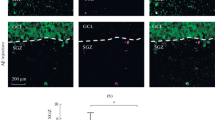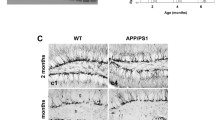The effects of intracerebroventricular administration of fragment (25–35) of β-amyloid peptide [Aβ(25–35)] on cell proliferation in the subventricular zone of the dentate gyrus of the hippocampus in adult rats were analyzed. Animals received doses of 15 nmol of pre-aggregated Aβ(25–35) or the Aβ(35–25) control peptide, or solvent (sterile water) into the lateral ventricles. On post-injection days 1–5, rats received intraperitoneal injections of the thymidine analog 5-bromo-2’-deoxyuridine (BrdU). BrdU incorporated into DNA was detected immunohistochemically on frontal brain sections six and 12 days after peptide administration. At six days, the numbers of BrdU-containing cells in the subventricular zone showed no differences between the study groups. At 12 days, the total number of BrdU-positive cells decreased significantly in all study groups. At the same time, the number of labeled cells in rats given Aβ(25–35) was significantly greater in this brain zone than in animals given water or the control peptide. Thus, Aβ(25–35) significantly increased cell proliferation in the subventricular zone after intracerebroventricular administration.
Similar content being viewed by others
References
F. H. Gage, “Neurogenesis in the adult brain,” J. Neurosci., 22, No. 3, 612–613 (2004).
T. Gong, L. Chang, K. Viola, et al., “Alzheimer’s disease-affected brain: presence of oligomeric A beta ligands (ADDLs) suggests a molecular basis for reversible memory loss,” Proc. Natl. Acad. Sci. USA, 100, No. 18, 10417–10422 (2003).
N. J. Haughey, D. Liu, A. Nath, et al, “Disruption of neurogenesis in the subventricular zone of adult mice, and in human cortical neuronal precursor cells in culture, by amyloid beta-peptide: implications for the pathogenesis of Alzheimer’s disease,” Neuromolec. Med., 1, No. 2, 125–135 (2002).
N. J. Haughey, A. Nath, S. L. Chan, et al., “Disruption of neurogenesis by amyloid beta-peptide, and perturbed neural progenitor cell homeostasis, in models of Alzheimer’s disease,” J. Neurochem., 83, No. 6, 1509–1524 (2002).
K. Jin, V. Galvan, L. Xie, et al., “Enhanced neurogenesis in Alzheimer’s disease transgenic (PDGF-APPSw,Ind) mice,” Proc. Natl. Acad. Sci. USA, 101, No. 36, 13363–13367 (2004).
K. Jin, A. L. Peel, X. O. Mao, et al., “Increased hippocampal neurogenesis in Alzheimer’s disease,” Proc. Natl. Acad. Sci. USA, 101, No. 1, 343–347 (2004).
M. A. Lopez-Toledano and M. L. Shelanski, “Neurogenic effect of β-amyloid peptide in the development of neural stem cells,” J. Neurosci., 24, No. 23, 5439–5444 (2004).
Y. Nakagawa, T. Yuzuriha, and T. Iwaki, “Active clearance of human amyloid β 1–42 peptide aggregates from the rat ventricular system,” Neuropathology, 24, No. 3, 194–200 (2004).
D. J. Selkoe, “Alzheimer’s disease: genes, proteins, and therapy,” Physiol. Rev., 81, No. 2, 741–766 (2001).
M. Yu. Stepanichev, M. V. Onufriev, O. S. Mitrokhina, et al., “Neurochemical, behavioral, and neuromorphological effects of central administration of beta-amyloid peptide (25–35) in rat,” Neirokhimiya, 17, No. 4, 278–293 (2000).
M. Yu. Stepanichev, I. M. Zdobnova, I. I. Zarubenko, et al., “Amyloidbeta (25–35)-induced memory impairments correlate with cell loss in rat hippocampus,” Physiol. Behav., 80, No. 5, 647–655 (2004).
Author information
Authors and Affiliations
Additional information
Translated from Morfologiya, Vol. 135, No. 1, pp. 13–16, January–February, 2009.
Rights and permissions
About this article
Cite this article
Stepanichev, M.Y., Moiseeva, Y.V., Lazareva, N.A. et al. Changes in Cell Proliferation in the Subventricular Zone of the Brain in Adult Rats Given β-Amyloid Peptide (25–35). Neurosci Behav Physi 40, 123–126 (2010). https://doi.org/10.1007/s11055-009-9232-5
Received:
Published:
Issue Date:
DOI: https://doi.org/10.1007/s11055-009-9232-5




